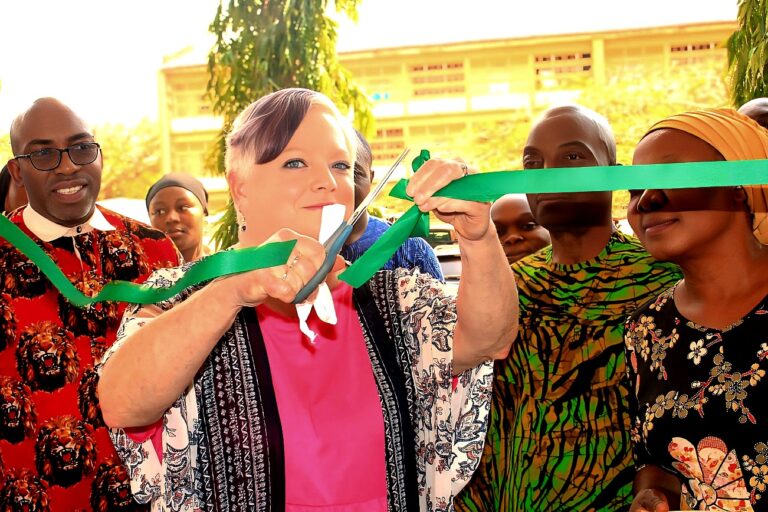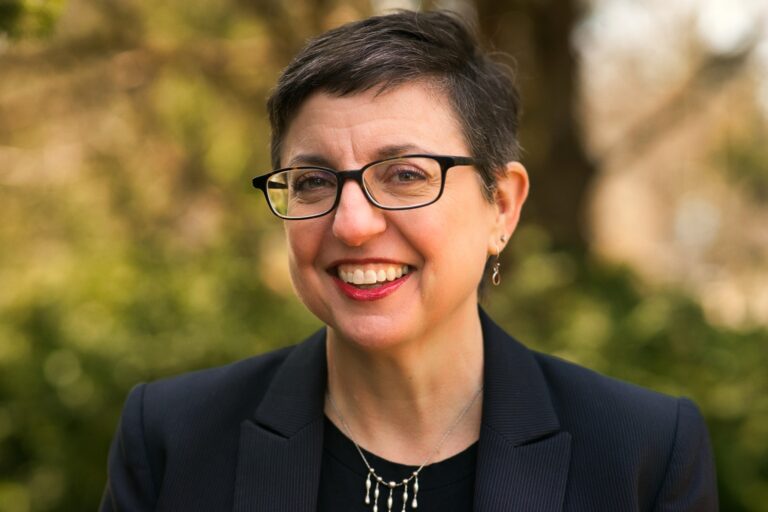Local Muralist and Professor Invite Trail-Goers to Reflect on Lansing’s Residential History
Ahead of impending snowfall, consider taking a winter stroll along the Lansing River Trail and pausing under the I-496 overpass.
Several concrete columns supporting the overpass are covered with a colorful assemblage of human faces. These paintings are the work of Brian Whitfield: an acclaimed muralist and Lansing local, who created the murals as part of the Pave the Way history project.

Across the Grand River and to the right of the trail, you’ll see a newly engraved poem on the wall, written by Dr. Nancy C. DeJoy with community members and co-writers Michelle Carlson, Levi Chappelle, Theresa Harrison, Jennifer Lamphere, Saebren Stevens, and Whitfield. The two stanzas are inscribed in black font against a gray backdrop, cleanly situated between other murals and the occasional graffiti tag.

Together, the murals and poem represent the collaboration of Whitfield, DeJoy – an Associate Professor in the Department of Writing, Rhetoric, and Cultures (WRAC) – and other Lansing residents and creative visionaries. The poem and murals brighten the underside of the I-496 bridge: a location along the 2023 ArtPath River Trail Exhibition, organized annually by the Lansing Art Gallery & Education Center.
A Neighborhood Commemorated on Concrete
In July 2023, City Pulse covered the creation of Whitfield’s murals, which enliven the columns below the bridge with the lives and likenesses of former residents. Whitfield’s work is regularly highlighted in Lansing and beyond, but these paintings are uniquely situated in Lansing’s residential history.
Over 50 years ago, a historically Black neighborhood thrived in the now-empty space below the I-496 overpass. Whitfield designed each mural to represent the faces of former residents in the neighborhood, rendered in his trademark style: a collage of curvy lines, geometric patterns, and bright colors. In all of his work, Whitfield is “inspired by how, as a community, we collectively view the world, our common victories, and personal struggles we all share,” he writes in a statement about the I-496 murals.
With knowledge of the I-496 project and its division of a vital Black community in Lansing, Whitfield’s bright compositions might seem to contradict their darker history. Yet in the same moment, these murals invite trail-goers to acknowledge and commemorate the neighborhood divided by the bridge, rather than simply walk by the past.
Poetic Listening is Not a Luxury
Across the river from Whitfield’s murals, a complementary poem – entitled “The Road Most Travelled,” a nod to Robert Frost’s “The Road Less Travelled” – serves as an additional invitation to pause, read, and remember the neighborly ties lost to the I-496 project.

The piece sprung out of a “poetic listening” session led by DeJoy. Poetic listening operates from the foundational belief that “we can’t have equity without the idea that agency is available to everyone,” DeJoy shared in a conversation with the WRAC Communications team.
Invoking this belief, DeJoy asked her co-authors to describe their reactions to Whitfield’s murals. She took notes on their responses, asked follow-up questions, and finally combined their thoughts, words, and feelings to craft a poem.
Now inscribed in the wall parallel to the trail, the poem encourages passersby to stand with the words and engage with Whitfield’s work across the river. Each reflective pause is a small-scale iteration of DeJoy’s poetry classes and workshops, but encourages a similarly powerful phenomenon of stopping and listening: whether strolling along the river trail or en route to work, home, or another familiar destination in Lansing.

DeJoy cites Audre Lorde as a key influence in her work as an educator and poet, and specifically Lorde’s essay “Poetry is Not a Luxury.” The piece underpins DeJoy’s poetic listening workshops, her past work with survivors of domestic violence and sidewalk poetry, and her ongoing work with students and Lansing-based organizations, including her current role as Poet-in-Residence of the Capital City Film Festival and creative collaborations with Whitfield and other artists.
Poetry, Lorde writes, is a “vital necessity” that compels writers to listen to cultural narratives of all kinds – from the story of a next-door neighbor to the history of the I-496 bridge – and grants permission to move beyond the traditional, academic confines of language. Where “that language does not yet exist,” Lorde writes, “it is our poetry which helps to fashion it.”
Across her work, Dejoy seeks to create spaces for witnessing, listening, and fashioning language to fill the gaps and silences that shape our lives. Poetry is a way of using language that allows people to describe their experiences with honesty and clarity, DeJoy explained, yet in ways that don’t permanently define or limit who they are.
Paving a Path Forward
Combining the power of poetry and painting, DeJoy and Whitfield look forward to future collaborations and community-engaged projects in Lansing.
Today, Whitfield continues his work on the second phase of a mural project at the Allen Neighborhood Center, located at the corner of Kalamazoo and Shepard for neighbors, shoppers, and marketgoers to enjoy. In addition to her collaborations with artists like Whitfield and support of MSU students, DeJoy is working on a project to support the sustainability of recently “delisted” species – those coming off the endangered species list – with printmaker Samantha Easley.

For more information about ArtPath, review the complete list of ArtPath 2023 locations on their website and plan your next reflective walk along the Lansing River Trail: more than two-and-a-half miles highlighting the work of Whitfield, Dejoy, and other talented local artists.


